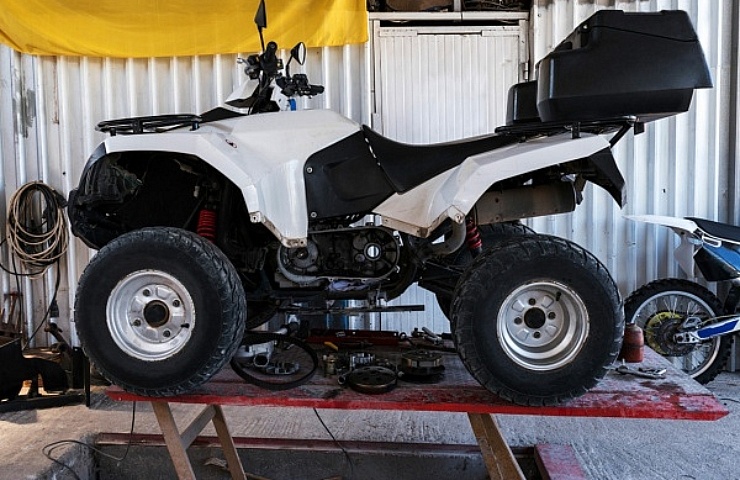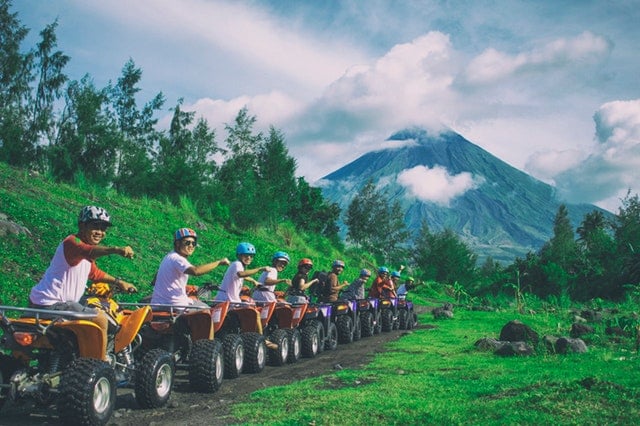ATV Mastery: A Comprehensive Overview to Off-Road Supremacy
ATV Riding Techniques: Understanding the Art of Off-Roading

Body Positioning
To properly browse with challenging off-road terrain, it is essential for ATV motorcyclists to consistently maintain appropriate body positioning. Preserving the appropriate body position while riding an ATV not just enhances control and stability but likewise guarantees the rider's safety and security. By embracing the appropriate body positioning techniques, bikers can properly disperse their weight, enhance their balance, and decrease the threat of injuries or mishaps.
One key aspect of correct body positioning is keeping the feet on the foot secures. Placing the feet on the foot pegs allows the biker to keep security and control over the ATV. The cyclist's knees must be somewhat curved, supplying a slight suspension to soak up shocks and maintain equilibrium. Additionally, the cyclist's upper body ought to stay relaxed and flexible, enabling smooth and fast movements when necessary. This consists of maintaining a light hold on the handlebars to preserve control without too much force.
Additionally, the rider's eyes should always be concentrated ahead, checking the terrain and anticipating any barriers or changes in the path. By maintaining a forward gaze, motorcyclists can make instant choices and respond suitably to challenging terrain.
Throttle Control
Structure upon the significance of correct body positioning for ATV motorcyclists, mastering throttle control is a vital ability that allows motorcyclists to successfully navigate with numerous off-road terrains. Strangle control refers to the capacity to control the amount of power supplied to the ATV's engine. By understanding exactly how to control the throttle, cyclists can guarantee a controlled and smooth acceleration, allowing them to browse challenges with accuracy.
Among the basic elements of throttle control is finding out to regulate the throttle smoothly. Unexpected or jerky activities can create the ATV to lose grip or end up being unsteady, making it challenging to keep control. Instead, riders should go for purposeful and progressive throttle inputs, particularly when passing through difficult surfaces. This strategy enables the ATV to preserve a consistent speed and provides far better grip, minimizing the risk of accidents.
In addition to smooth inflection, riders should likewise learn just how to stabilize the throttle with other riding techniques, such as body positioning and stopping. For instance, when climbing up steep hills, motorcyclists require to use adequate throttle to keep momentum without triggering or overpowering the atv wheel spin. In a similar way, when descending high slopes, bikers must make use of the throttle in combination with appropriate body placing and braking to maintain control and stop the ATV from gliding or tipping over.

Braking Methods
A necessary aspect of ATV riding techniques is grasping reliable stopping methods. Understanding just how to brake correctly can make a significant difference in your safety and security and control over the vehicle when it comes to off-roading. Among the most crucial braking techniques is making use of the front brake greater than the back brake. The front brake supplies the majority of the stopping sites power, so it is vital to utilize it carefully. Nevertheless, it is very important to keep in mind that harsh stopping with just the front brake can cause the ATV to pitch forward, potentially bring about loss of control and even flipping over. It is advised to apply both brakes concurrently, but with even more stress on the front brake. An additional crucial method is to prevent locking the wheels while braking. Securing the wheels can result in skidding, making it hard to preserve control. To avoid this, press the brake levers progressively and go to this website release them a little if you really feel the wheels securing. By mastering these braking methods, you can improve your ATV riding abilities and ensure a secure and pleasurable off-roading experience.
Cornering Methods
One essential aspect of understanding ATV riding strategies is recognizing reliable cornering strategies. Collaring on an ATV can be difficult, however with the appropriate methods, riders can navigate turns safely and efficiently. The secret to successful cornering is to preserve control of the ATV while optimizing grip and lessening the threat of toppling.
To implement a correct cornering technique, riders must approach the turn at a suitable speed, guaranteeing they are not going too sluggish or too quick. It is critical to shift the body weight towards the inside of the turn, leaning right into it to keep equilibrium and security. This assists for the centrifugal force and maintains the ATV upright.
In addition, cyclists ought to maintain their directory eyes focused on the departure factor of the turn as opposed to the prompt path ahead (ATV). This permits smoother and more accurate guiding, as it helps the biker prepare for any obstacles or modifications in surface
Additionally, proper throttle control plays a considerable function in cornering. Cyclists have to regulate the throttle efficiently, preventing unexpected velocities or slowdowns, which can create loss of control.
Uphill and Downhill Riding
When browsing off-road surface, ATV cyclists need to master the methods for uphill and downhill riding to preserve control and make sure safety and security. Uphill riding requires a mix of balance, throttle control, and weight circulation. As motorcyclists ascend steep inclines, they need to lean ahead to change their weight in the direction of the front of the ATV, which raises traction on the front wheels and stops the lorry from turning in reverse. ATV. Furthermore, keeping a consistent throttle and staying clear of sudden acceleration or slowdown assists to protect against the ATV from losing momentum or getting stuck. Downhill riding, on the other hand, calls for riders to lean back and shift their weight towards the back of the ATV. This helps to maintain stability and prevent the car from flipping onward. It is vital to use the brakes moderately and use them progressively to avoid securing the wheels and blowing up. Cyclists ought to select the course with the least obstacles, as navigating downhill can be more tough due to the enhanced speed and lowered grip. By mastering the techniques for uphill and downhill riding, ATV riders can with confidence take on numerous off-road surfaces and delight in a risk-free and exciting experience.
Verdict
To conclude, understanding the art of ATV riding requires a combination of body positioning, throttle control, braking methods, and efficient cornering. Uphill and downhill riding likewise need certain skills to browse safely. By carrying out these techniques, cyclists can enhance their off-roading experience and enhance their total control and safety and security on the ATV.
ATV Riding Techniques: Understanding the Art of Off-Roading is an extensive guide that dives into the intricacies of grasping the skills required for off-road ATV riding. Whether you are a newbie or a knowledgeable motorcyclist, ATV Riding Techniques: Grasping the Art of Off-Roading offers crucial suggestions to aid boost your off-road ATV riding abilities to the next degree.
